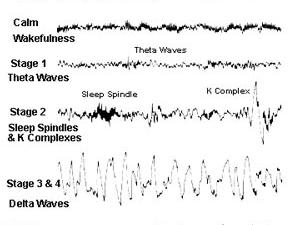Short Description
Fasting improves the quality and intensifies the depth of sleep, a matter of particular importance to the aged who have much less stage three and four sleep (deep sleep). The processes of repair of the body and of the brain take place during sleep. Two hours of sleep during the
Fasting Positively Affects Sleep
During the first few hours of an Islamic fast, the EEG is normal. However, the frequency of the alpha rhythm is decreased by a low blood glucose level. This may happen at the end of the fasting day towards evening when the blood sugar is low.
Fasting improves the quality and intensifies the depth of sleep, a matter of particular importance to the aged who have much less stage three and four sleep (deep sleep). The processes of repair of the body and of the brain take place during sleep. Two hours of sleep during the month of Ramadan are more satisfying and refreshing than more hours of sleep otherwise!
REM sleep and dreaming are closely associated. Dreaming may be necessary to maintain health, but prolonged REM deprivation has no adverse psychological effects. Dreaming sleep occupies 50% of the sleep cycle in infants and decreases with age.
Brain synthetic processes occur in deep sleep; brain protein molecules are synthesized in the brain during deep sleep or used in REM sleep in restoring cerebral function. Fasting significantly increases deep sleep and leads to a fall in REM sleeping time or dreaming time, and also accelerates synthesis of memory molecules.
Fasting & the Circadian Rhythm
The period of the circadian pace-maker in humans is 24 hours 11 minutes. Hormonal secretion is frequently characterised by rhythmic fluctuations which may be regular or irregular in periodicity. The period of regular oscillation may be as short as a few minutes or as long as a year.
The body timing system that drives circadian rhythms is exposed to external factors ranging from the imposed activity-rest cycle, the natural light-dark cycle, and social activities outside the workplace.
There are biological pacemakers or oscillators within the body with time-keeping capacity which synchronise with the external environmental cycles such as light. Environmental cues that synchronize biological pacemakers are called “zeitgebers” (from the German “time-givers”), and the process of re-setting the pacemaker is called re-synchronization.
The light/dark cycle is a potent zeitgeber for circadian rhythm but daily cycles in temperature, food availability, social interaction (such as congregational prayers) and even electro-magnetic field strength synchronize circadian rhythm in certain species.
Because of recurring cycles of light, temperature and food availability, organisms evolved endogeous rhythms of metabolism and behavior providing response to specific environmental cycles. Many biological rhythms reflect the period of one of four environmental cycles: cycles of the tide, of day and night, of moon phase and of seasons.
Muslims who have been fasting regularly since childhood, have been exposed to different sleep/wake and light/darkness cycles on a daily basis in one annual lunar month. Hence, it may be easier for such persons to synchronize their circadian, circalunar and circannual biological rhythms under difficult conditions.
Keep Tuned........






![نصيحتي لك: اذكر الله [1 / 12] نصيحتي لك: اذكر الله [1 / 12]](https://300035.dotdothktrade.tech/images/upload/content_thumbs/1913613138ragheb-al-serjany-videos.jpg)


Comments
Send your comment